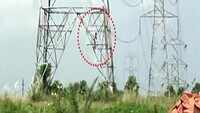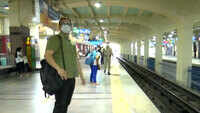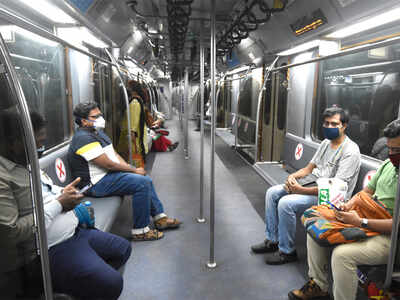
KOLKATA: Sanitized coaches, social distancing, relative ease of travel... the city’s commute lifeline, the Metro — the country’s oldest — was back on track on Monday in a new avatar. Under the rules of ‘new normal’, gone were the familiar scenes of manic rush-hour madness; the usual pleas of “Dada, ektu chepe boshun” were not required since only every other seat was occupied.
No one would mistake it for a return to the old days. The Kolkata Metro had only about 20,000 riders on Monday, a far cry from the ‘old normal’ of 6.6 lakh. But it was a huge step towards normality, amidst the pandemic.
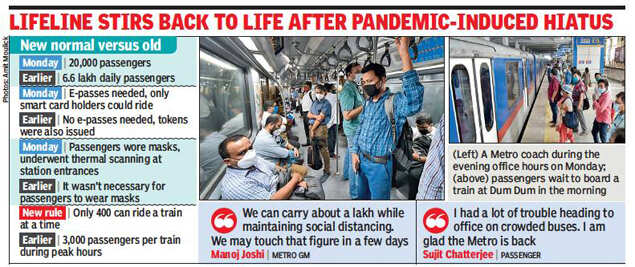
Gautam Mondal, who was the first passenger to step into the first train that chugged out of Dum Dum, was pleasantly surprised, and welcomed the absence of crowds. “This is how train rides should be in a civilised city,” he told TOI. Sujit Chatterjee, who has to use a walking stick, and was finding it difficult to board a bus to go to office, said: “I am glad the Metro is back.”
For the frequent Metro user, Monday’s experience — of travelling on empty coaches even from Esplanade, one of the busiest stations otherwise — was almost surreal. There were some hiccups, but without having any effect on the day’s operations. “That was only expected,” said Metro Railway general manager Manoj Joshi. “People are not used to booking QR-coded passes to access Metro stations. They will take a little time to understand how easy it is to download the pass. They will surely opt for Metro, which is safer than most modes of public transport.” Under the new reservation system, passengers must book e-passes, clicking the URL https://pathadisha.com/metro/, to enter a station.
The e-pass model for crowd management seemed to have piqued interest around the country. On Monday, state transport officials received calls from Mumbai Central Line and DRM, Mumbai and Mumbai Metro Rail Corporation (MMRC). They wanted to understand how Kolkata Metro’s e-pass worked. Maharashtra is worst hit by Covid-19 and is looking for ways to start its suburban rail and Metro networks. “Mumbai Central Line general manager has taken the details from us and we put them on to the state transport department,” Joshi said. “Our system has turned out to be a model for crowd management.”
The Mumbai suburban railway is one of the world’s busiest commuter rail systems. Electronic OR-based e-passes are being issued to essential service staff to take the few local trains plying in Maharashtra during the pandemic.
“The passes issued by the Maharashtra government are only meant for a limited few. The railway decides who gets the passes. Our system is democratic. It empowers the common man to self-generate. If he misses one slot, he goes to the next one,” Joshi said.
State transport department officials, who helped find this solution for crowd-control in the Metro that is saddled with the highest per-kilometre passenger density, said Metro’s low footfall on its debut run was mainly because multiple slots were booked by those who had no intention of travelling. The genuine commuter, thus, failed to take a ride.
While 52,000 passes were downloaded, only 20,000 rides were availed of. On Monday evening, 12,000 passes were downloaded in an hour, up from 9,000 passes an hour of Sunday evening. Save this mismatch between pass downloads and actual commute count, the operations were smooth.
The 20,000 passengers that the north-south line carried on Monday earned it a revenue of Rs 11,19,55. East-West had only 83 passengers and clocked a revenue of Rs 6,610. In all, the north-south line had 110 trains, whereas there were 74 trains on the East-West line.
No one would mistake it for a return to the old days. The Kolkata Metro had only about 20,000 riders on Monday, a far cry from the ‘old normal’ of 6.6 lakh. But it was a huge step towards normality, amidst the pandemic.

Gautam Mondal, who was the first passenger to step into the first train that chugged out of Dum Dum, was pleasantly surprised, and welcomed the absence of crowds. “This is how train rides should be in a civilised city,” he told TOI. Sujit Chatterjee, who has to use a walking stick, and was finding it difficult to board a bus to go to office, said: “I am glad the Metro is back.”
For the frequent Metro user, Monday’s experience — of travelling on empty coaches even from Esplanade, one of the busiest stations otherwise — was almost surreal. There were some hiccups, but without having any effect on the day’s operations. “That was only expected,” said Metro Railway general manager Manoj Joshi. “People are not used to booking QR-coded passes to access Metro stations. They will take a little time to understand how easy it is to download the pass. They will surely opt for Metro, which is safer than most modes of public transport.” Under the new reservation system, passengers must book e-passes, clicking the URL https://pathadisha.com/metro/, to enter a station.
The e-pass model for crowd management seemed to have piqued interest around the country. On Monday, state transport officials received calls from Mumbai Central Line and DRM, Mumbai and Mumbai Metro Rail Corporation (MMRC). They wanted to understand how Kolkata Metro’s e-pass worked. Maharashtra is worst hit by Covid-19 and is looking for ways to start its suburban rail and Metro networks. “Mumbai Central Line general manager has taken the details from us and we put them on to the state transport department,” Joshi said. “Our system has turned out to be a model for crowd management.”
The Mumbai suburban railway is one of the world’s busiest commuter rail systems. Electronic OR-based e-passes are being issued to essential service staff to take the few local trains plying in Maharashtra during the pandemic.
“The passes issued by the Maharashtra government are only meant for a limited few. The railway decides who gets the passes. Our system is democratic. It empowers the common man to self-generate. If he misses one slot, he goes to the next one,” Joshi said.
State transport department officials, who helped find this solution for crowd-control in the Metro that is saddled with the highest per-kilometre passenger density, said Metro’s low footfall on its debut run was mainly because multiple slots were booked by those who had no intention of travelling. The genuine commuter, thus, failed to take a ride.
While 52,000 passes were downloaded, only 20,000 rides were availed of. On Monday evening, 12,000 passes were downloaded in an hour, up from 9,000 passes an hour of Sunday evening. Save this mismatch between pass downloads and actual commute count, the operations were smooth.
The 20,000 passengers that the north-south line carried on Monday earned it a revenue of Rs 11,19,55. East-West had only 83 passengers and clocked a revenue of Rs 6,610. In all, the north-south line had 110 trains, whereas there were 74 trains on the East-West line.

Coronavirus outbreak
Trending Topics
LATEST VIDEOS
City
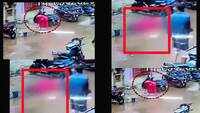 On cam: 35-year-old woman dies of electrocution after she steps on a live wire in Chennai
On cam: 35-year-old woman dies of electrocution after she steps on a live wire in Chennai  Government prohibits onion exports as prices treble in a month
Government prohibits onion exports as prices treble in a month 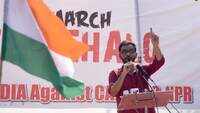 Delhi riots: Ex-Jawaharlal Nehru University student Umar Khalid sent to 10-day police custody
Delhi riots: Ex-Jawaharlal Nehru University student Umar Khalid sent to 10-day police custody 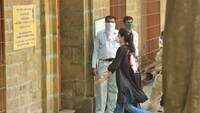 SSR death probe: Rhea Chakraborty used her mother's phone to dial drug peddler
SSR death probe: Rhea Chakraborty used her mother's phone to dial drug peddler
More from TOI
Navbharat Times
Featured Today in Travel
Get the app
